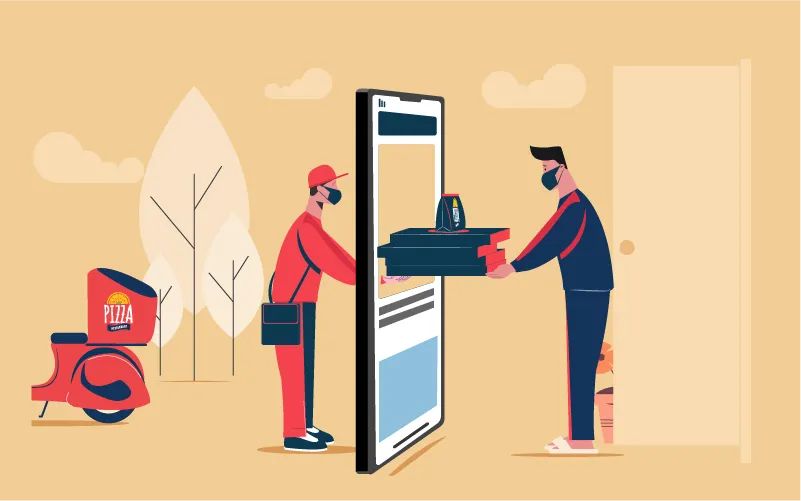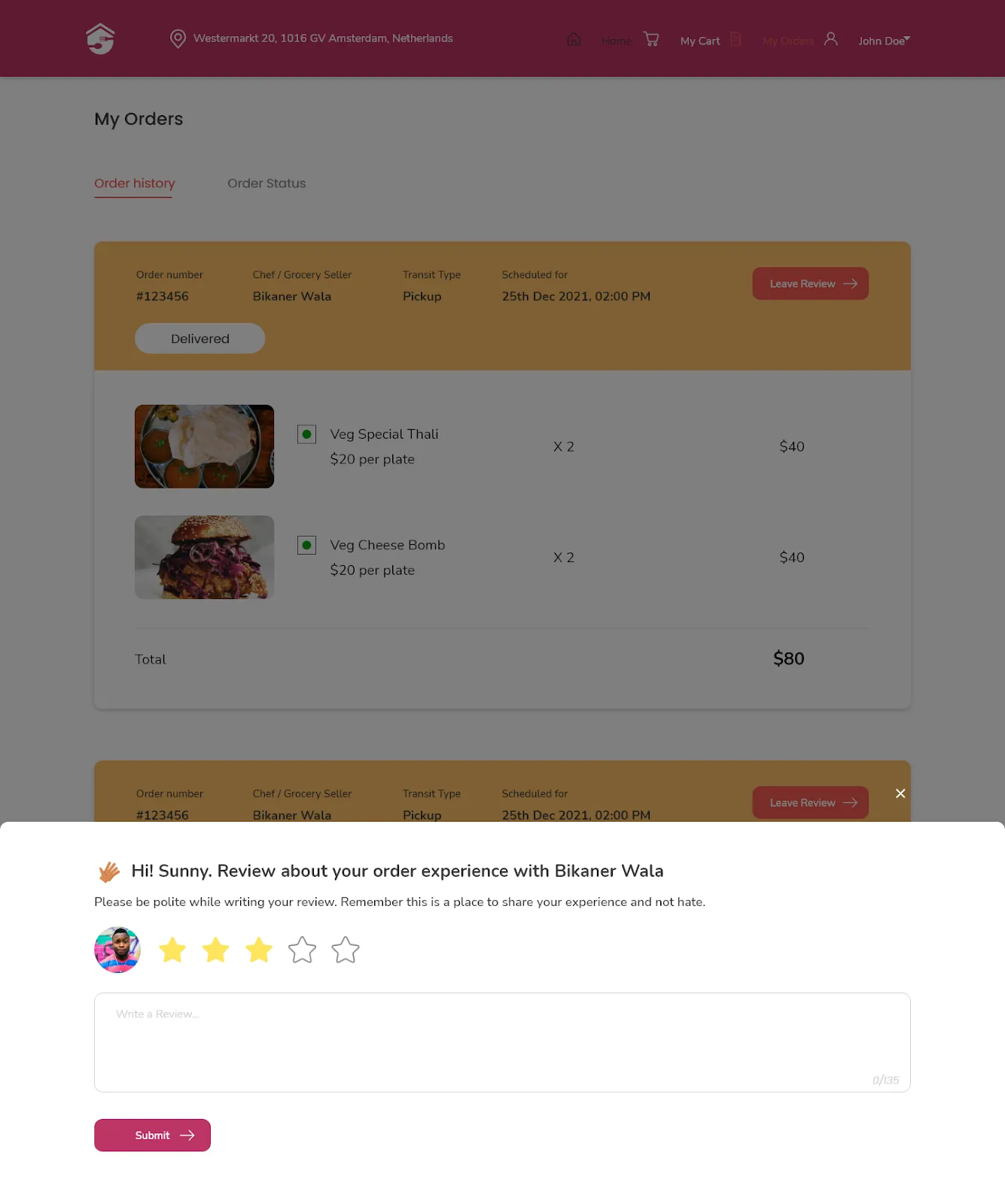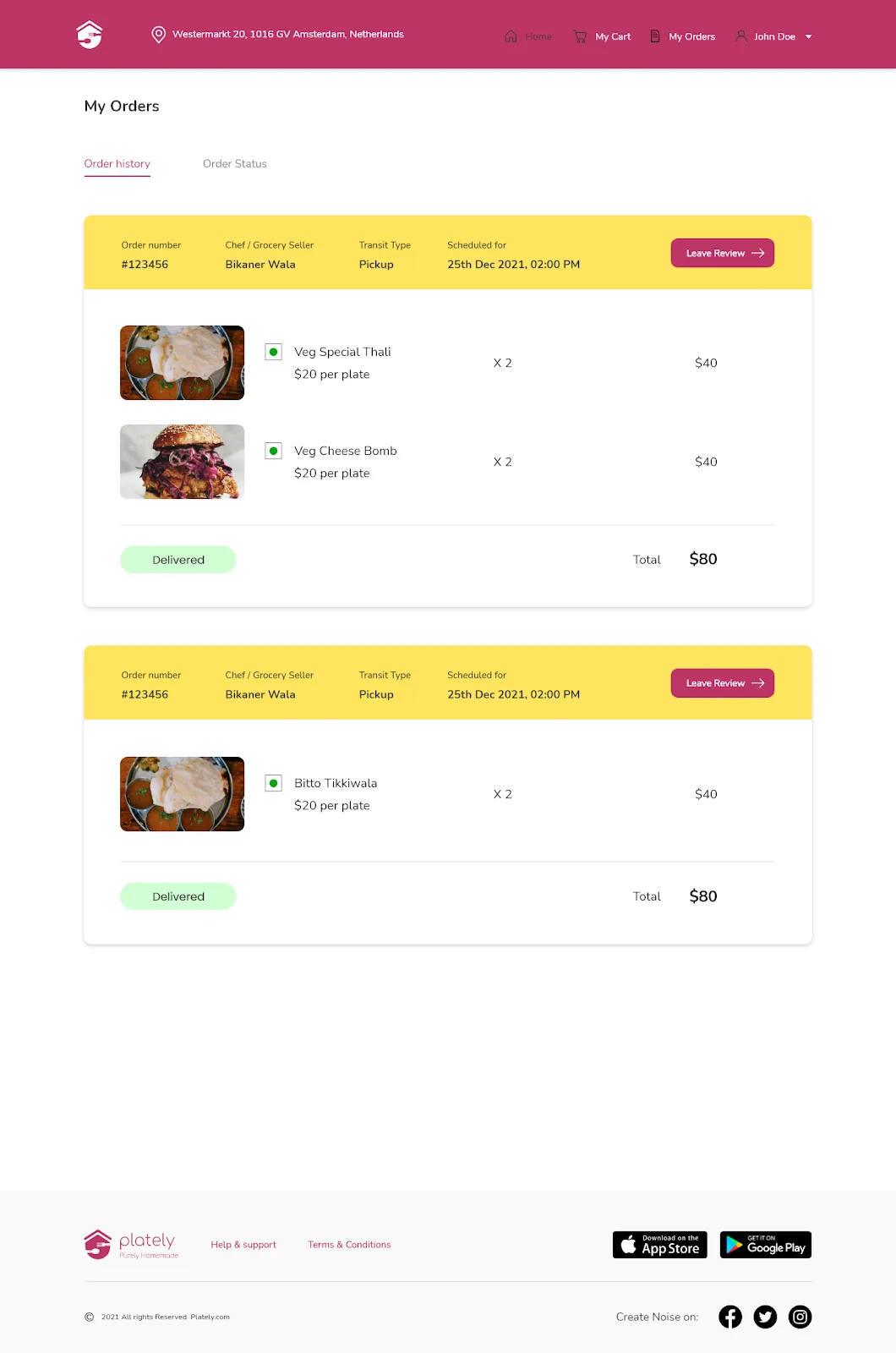Technology

6 min

This blog is a comprehensive guide for building a food ordering app, covering everything from ideation and design to development and deployment. With our experience in building custom food ordering apps, you'll be equipped to launch your own app with confidence.
By Supratika Nandi
18 May, 2021
There is a high probability that you have often thought about delivering smiles to people's faces and winning their hearts by giving them good food on time or within minutes or making those happy who know how to make tasty food (home chefs) and make money.
With technological advancements, delivering food to customers' doorsteps is easy. The food delivery business thrives with abundant opportunities as it gains more growth.
Getting into a food delivery business is the best opportunity since it's an evergreen business model. It demands full access to inventory because of the convenience of food.
Food delivery apps like Zomato, Swiggy, Uber Eats, Careem, Dunzo, Pizza Hut, Foodpanda, or Doordash are on everyone's mind. Whenever food lovers feel to have home-cooked meals, they order from these apps on their mobile phones.
Online food delivery apps are popular these days and vital smartphone apps. There are a lot of user-friendly iOS and Android mobile apps for ordering food. Good food in today's time is just a few clicks away.
With new norms of social distancing amid the ongoing Covid-19 pandemic, more and more people want food delivered safely to home. It's one of the many reasons food delivery apps are more in demand than ever.
Food app developers understand the customers' preferences, safety, comfort zones, favorite restaurants, location, etc. They strive to add related features to a food delivery app so customers can dine happily. Some also add elements to attract more users by offering great deals to save some pennies.
But there is enormous competition in developing a food delivery app and the food delivery business.
Most people think of launching such a business model with little to no difference from their competitors, and when you think about doing it, too, you consistently get succumb to a vicious circle of questions -
And so on. It's a never-ending list of such questions!
You have reached the right place if you are going through the same cycle and feeling it hard to spin your head around any of the questions we shot above.
In this definitive guide, you will go through a beautiful journey and practical examples of successful food delivery apps while navigating the exact roadmap of how to start and end a project is related to developing a food ordering app from scratch.
You will also discover how it might become another revenue-generation source for you as an enthusiastic entrepreneur. First, to begin with selected geographies, the key is to conquer the hyper-local food markets and then percolate the business scope beyond them.
It would help if you were confident in picking the right set of USPs (unique selling points) and determine a value proposition that fits your business's mission and vision at its very best. Selecting the right set of target audiences is critical, and once you gain control over a smaller share of the market, you can start expanding.
In addition to that, this guide will also focus on the financial aspects of setting up a homemade food ordering chain.
Things like -
And much more.
Keep your seatbelts tight because we're going on an adventurous ride of a food delivery app development process.
Let's begin!
But just before going full throttle about it, let's look at concrete evidence and determine whether investing in the food delivery app development will even be a good choice for you.
According to Statista, revenue in the Online Food Delivering segment is projected to show a yearly growth rate of 8.38% for CAGR 2022-2026 and is expected to reach USD 343.80 billion in 2022.
The same stats for 2020 were USD 122,739 m, and the revenue was expected to witness an annual growth rate (CAGR 2020-2024) of 7.5%, occurring in a market volume of US$ 164,002m by 2024. It's a massive positive number shift favoring online food delivery businesses.
As per the data, the market share of people ordering food online is rising. Also, amid the pandemic, the intensity has soared, and people prefer fresh and hygienic food delivered safely to their doorsteps. That's a clear sign for you to go for a mobile app without any doubt.
Creating a people-friendly food-ordering app or an app that people love to have will help you become a significant part of the market and churn out excellent profits for you.
There are specific responsibilities and perks you would be accountable and entitled to when you operate a food ordering app.
Here are a few joint opportunities and Likelihoods to keep you excited as well as alarmed before the app goes live:
While many industries are affected adversely by the pandemic, the food ordering industry is among those who consider this pandemic a blessing in disguise.
The pandemic has left people terrified to step out of their homes. The online mode of food ordering has temporarily shunned offline food takeaways and is currently paused.
However, some businesses continue to flourish, and some are gradually coming back on track with their new business models.
Instead of delivering from a third-party vendor, people feel safe using your exclusive app to rely on it whenever they order food online.
When you choose a dedicated app for your business, you step forward to connect with your audience personally. Customized ads, responses, and food options are just a few ways to keep them committed to your mobile app.
Delivery delays are familiar, and we know how frustrating it gets for customers sometimes. Online deliveries are a concern when the order needs to reach customers promptly. It can affect your app review and sales and raise questions about the quality of services that could be better for the business, especially when starting.
You know that an additional value is permanently attached to online food orders. When you place an order while availing of a cheaper rate, you always consider whether you should go offline for the same item.
However, there are certain marketing gimmicks to try when new to the online food ordering business. You can opt for coupons; the first order is free, or discounts when you gradually grow and want people to be fond of you - just like Amazon and Groupon do to attract customers.
Before you deep dive into building an extensive and elaborative mobile application while investing heavily in its development, it's essential to know the food delivery market first.
It includes researching the key players that are your competitors and customers and what geographies/locations you should be targeting while also staying ahead of the curve with the latest technology stack and the features that make your food ordering app up-to-date and user-friendly.
There are two primary models to get your food delivered -
To decide which one fits the best with your business requirements, you must stress over these questions:
Once you have a firm knowledge and understanding of how you want your business model to work, take your pick, and customize the app accordingly.
Now that you are sure which market to target and the mode of delivery to follow, it's time to dive into structuring how the users will perceive your app.
Here is a list of some must-have features an excellent online food ordering the app must consist of -

There can be either one or two sets of potential application users—first, the customers who avail of the services, and second, the vendors who deliver the services. There should be a clear option for the end-users to choose and select the option that resonates with them.

Your registration page should always be chaos-free and should not bother the users with too many fill-in-the-blanks.
Always stick to minimalism and only ask for basic information like email ID, password, and phone numbers. Also, there should always be quick options to integrate with an existing Facebook or Google Account.

Once a user registers themselves as an active user of your app, it's time for them to set up their profile pages.
Again, the key is to finish the set-up in as few clicks as possible. Wrap it up by asking for a profile picture, current location, delivery address, and finally, the payment details or method they wish to use.
Now that the registration page and other things are inside your app, they I would love to scroll and see what options you have got.

Drop a clear search field for your users to start typing and catch hold of nearby restaurants, popular food outlets, and buzzing Cafes per their current location.
You can also choose to reflect certain offers associated with a particular place right beneath their descriptions.
Ordering food online is an impulsive decision. So an enticing CTA (call to action) a button that makes a customer place an order every time they skim through the list can work in your favor.


But that is a process that takes time. So before they hit the "Place Order." button, they make changes many times to their orders to make sure they are ordering what they want to have.
Make sure it's a seamless journey for them while they do so. They may add and remove food items multiple times and even change restaurants. However, it should always be a smooth process for your users.
Their actions to tweak their orders should not ultimately take more than three clicks.
This phase is where the food ordering cycle might break, and no revenue generation happens, so to dodge that, your UX and overall user experience should be top-notch.

When a customer finally checks out an item and is ready to make an online payment, it's crucial that the user feels secure and can get through the payment gateway in the most convenient ways possible.
The steps must also be swift and seamless without any hiccups or lags.
While the customer should not at any time feel they do not have access to their preferred mode of payment, it's a good idea to provide them with all the possible options like paying through e-wallets like PayPal, Apple Pay, and Google Pay, as well as card transactions and COD.
Flexibility to track orders is a feature people love to have in an online ordering food app installed on their device.

Once the user enables Location API (offered by Core Location and Google for iOS and Android, respectively), both parties can use their current location to determine the approximate time and feasible route to make the order reach its destination.
Only some customers will be glued to your app to track their real-time deliveries. However, it's still essential they are notified when their order gets placed, is on the way, or when it will be delivered.
Besides this, push notifications related to discounts, offers, and simple ads can also pop up on their devices once they opt for such messages every time there is an activity on an app.
Now, you have done your part at the end of putting an option to allow push notifications, you have done your part. Now it's time to wait for the results!
It is going to happen with an impactful feedback mechanism. Positive feedback and 5-star ratings would help more users catch a hold of your food ordering app and use it.

To make that happen, either you provide ultimate or at-par services to users of your services or politely ask your users to give authentic and positive feedback.
After the successful delivery of their order, ask -
And, etc.
People love to put up good reviews and words when they are genuinely happy with the services of a new app in the market like Blinkit .
But the same is true for a non-delightful experience as well.
So it would help if you were prepared for a mix of reviews and feedback you get for your services.
People love to keep track of their orders and wish to repeat the same with every food item they ordered from a particular restaurant or a particular place.

For this, order histories help them do so without any hassle, enhancing the overall user experience.
If you want people to get attracted to your business and its app, you would never put the existing ones away; offering discounts and rewards is an excellent way for your users. It truly works!
Who would prefer discounts and a few bucks off on the original price?
You can give particular preferences to the restaurants that always want to be listed on the top of your rating chart via paid sponsorships.
Choosing the right technology and framework will significantly impact you if you want to ensure a seamless user experience similar to that of Uber Eats , Zomato , or Domino's Pizza . Even though there are specific platforms to choose from, it's vital to pick the right sets of tools to align them with what your food-ordering business needs.
Here are a few of the best options to consider and assist you in creating a power-packed mobile application -
1. Best Mobile App Development Languages
2. Best Backend Development Tools and Languages
3. Best Frontend Development Tools and Languages
4. Best Libraries and Frameworks
When you choose to develop an app, you need a team of technocrats to create a robust mobile application.
The team broadly consists of many software engineers, front-end/back-end developers, project managers, iOS/Android developers, quality analysts, and specialized UI/UX designers to bring what you happen to have in mind.
It comes with a cost and external services like creating a customer app, courier app, etc.
For Play Stores, you must pay a one-time fee of $25 per post, which you can upload your application to Google Play Store for your target audience to use.
Similarly, for the App Store, $99 is charged to publish your application and make it live for the audience to install your application.
Have you been yearning for delicious homemade cooked food and groceries right from your neighborhood to pamper your taste buds?
Do you have culinary skills and love cooking, and would like to make money by establishing a whole business?
Are you thinking of an idea through which you can make people happy by presenting them with homemade cooked food right at their doorstep with their comfort and convenience?
You have acknowledged people's first love on Earth - Food! It is enriching and mind-soothing to cook a wide variety of dishes. You get to learn a lot when you cook. What amount of ingredients is needed for taste? It comes with practice, experimentation, and years of experience.
And if you think and feel you have it all, below is the list of apps to get inspired to open an online food business and invest in an online food delivery app development to connect to food lovers -
PlateLy is such an idea for building an app where your dream of starting a business right from your home will enable you to make money.

This business idea running in Holland, Netherlands, allows you to showcase your hidden talent in cooking food and get enormous admirers all over your surroundings, country, or even the whole world for your culinary skills.
Through this app, you can make people enjoy the taste and flavor of authentic recipes cooked to perfection from your end.
This platform brings you a top-notch combination of health, taste, nutrition, and hygiene, with the touch of up-to-the-mark preparations by people enthusiastic about food from your neighborhood.
Choose a company that understands your exact website and all mobile app development requirements for your online food delivery app development. You can effectively choose the right app that would fit perfectly into your business and ultimately produce it with the most user-friendly approach. Find a reliable online food delivery app provider who can treat your projects like theirs so that you have what you want.
Top 11 Must-Have Features of a Custom Web Application in 2026
By Dhruv Joshi
5 min read
Generative AI Tech Stacks: Choosing the Right Tools for Scalable AI Development
By Dhruv Joshi
5 min read
Choosing Best Tech Stack for Web App Development: Performance, Cost, and Scalability
By Dhruv Joshi
5 min read
Top 9 Tech Stacks for Scalable Web Application Development
By Dhruv Joshi
5 min read

Technology

7 min
Generative AI is moving fast into enterprises, from banks to hospitals to government agencies. Adoption is rapid, but security planning lags. Unlike traditional systems, these models can be exploited through prompt injection, poisoned data, or manipulated to leak sensitive information. They are also misused for phishing, deepfakes, and malicious code.


Technology

7 min
AI-powered Web Application Firewalls (WAFs) go beyond static rules by using machine learning, anomaly detection, and predictive analysis to block zero-day threats, reduce false positives, and protect APIs at scale. Unlike traditional WAFs, they self-learn, adapt in real time, and cut operational costs while improving compliance and trust.


Technology

5 min
AI is redefining mobile app security by transforming how threats are detected, tested, and prevented. From continuous monitoring and fraud detection to compliance with regulations, AI ensures apps remain resilient against modern risks. This means safer apps, protected users, and stronger businesses. Investing in AI-driven security today builds trust, drives growth, and secures long-term competitive advantage.


Feeling lost!! Book a slot and get answers to all your industry-relevant doubts